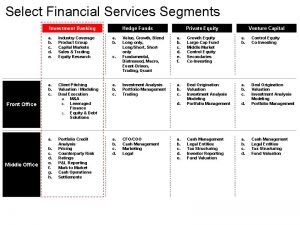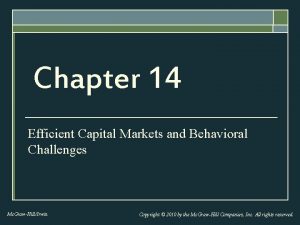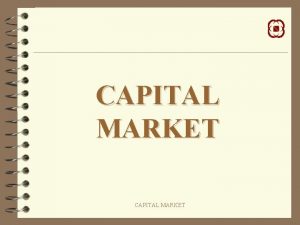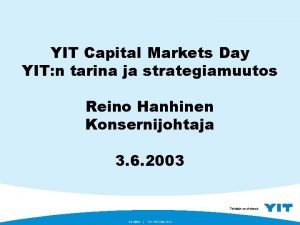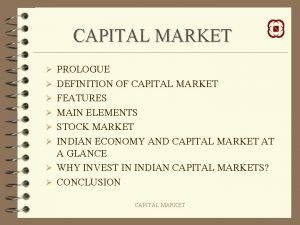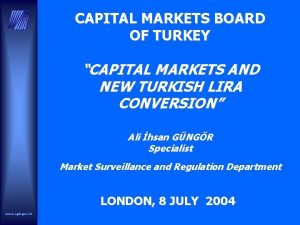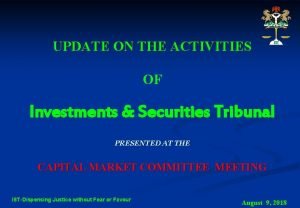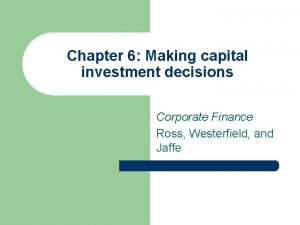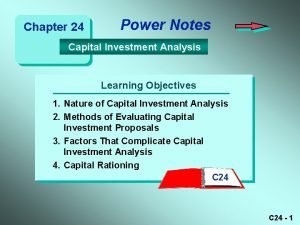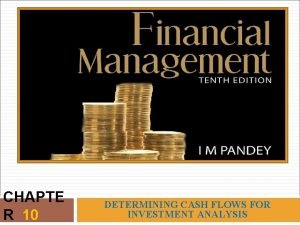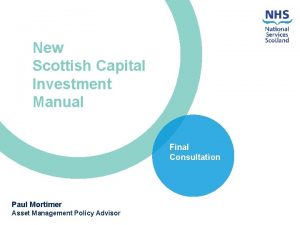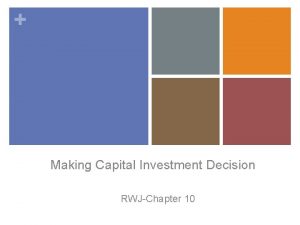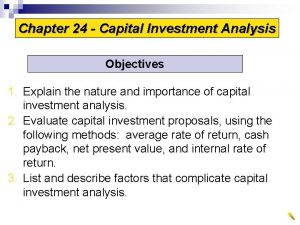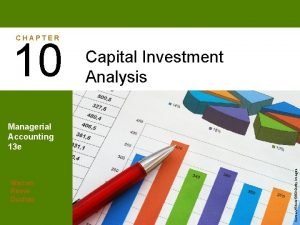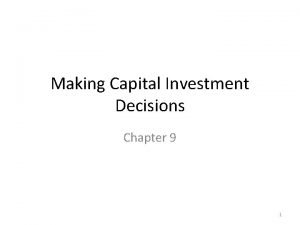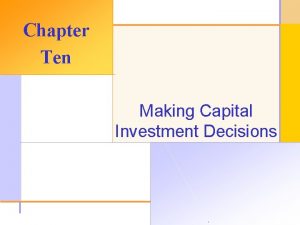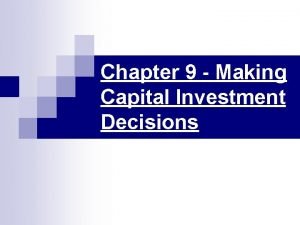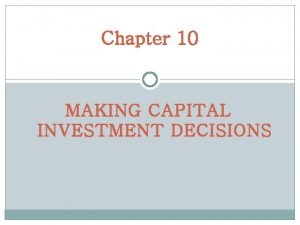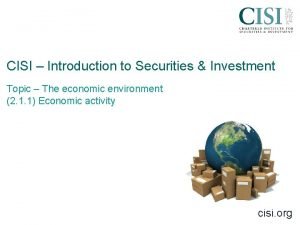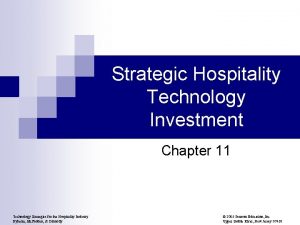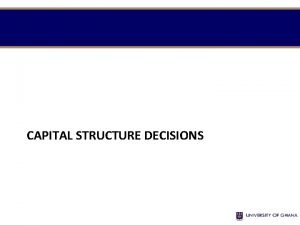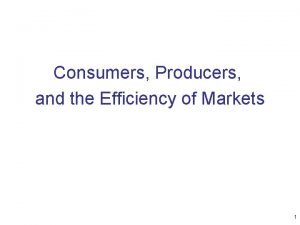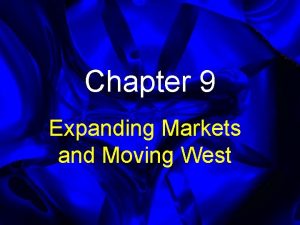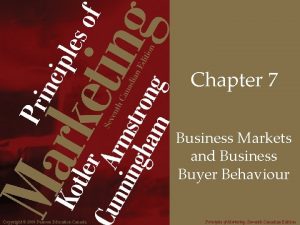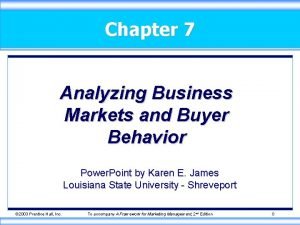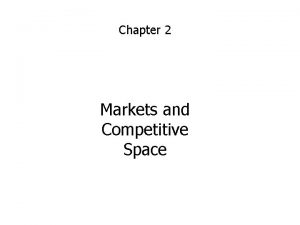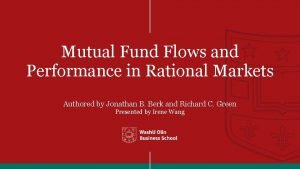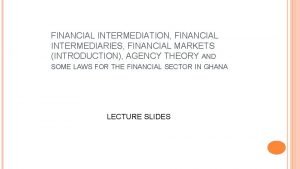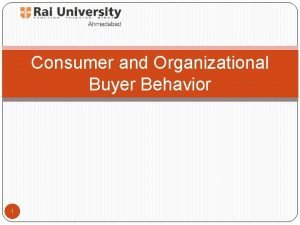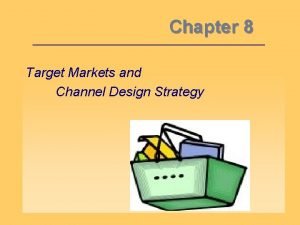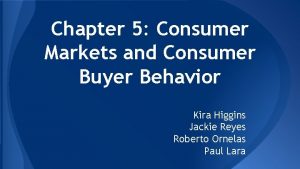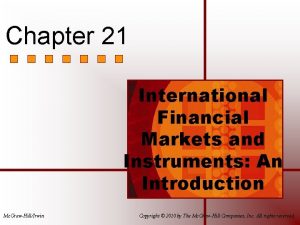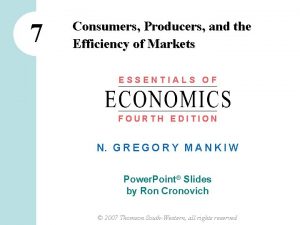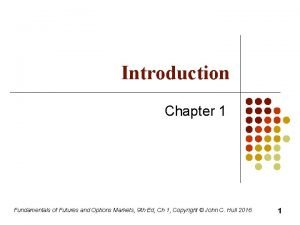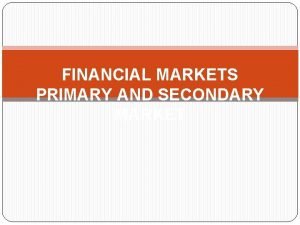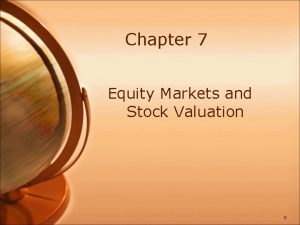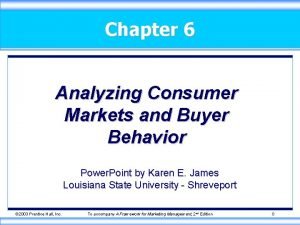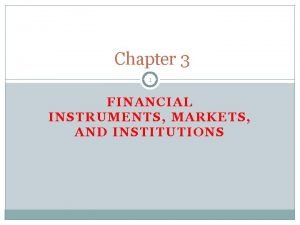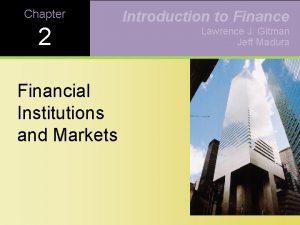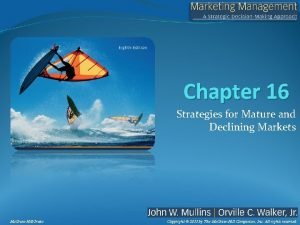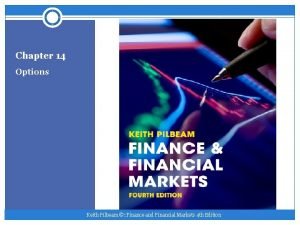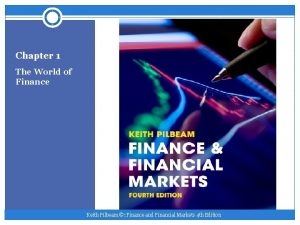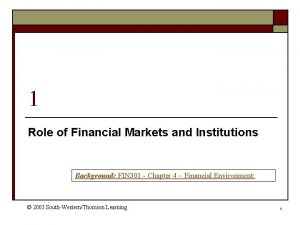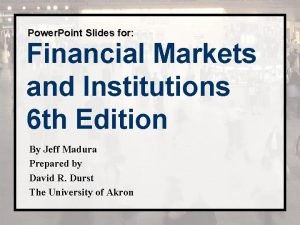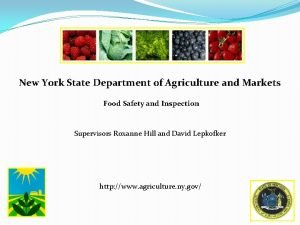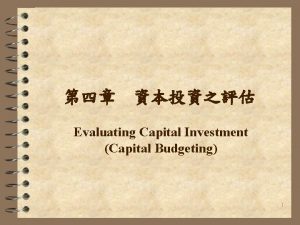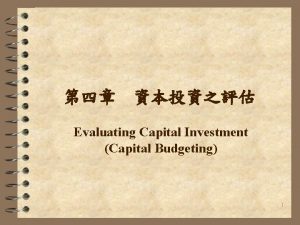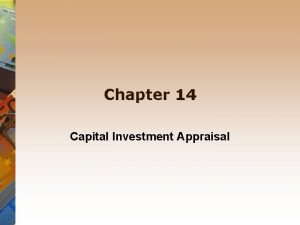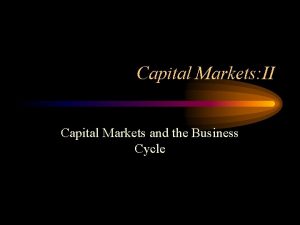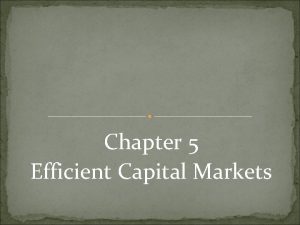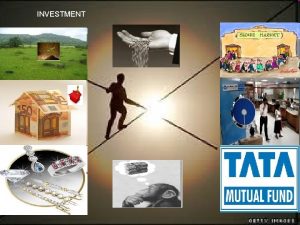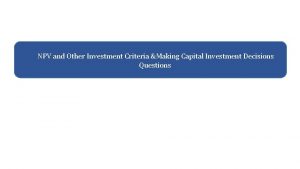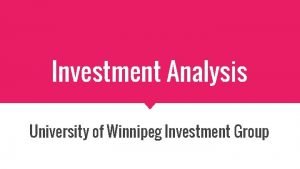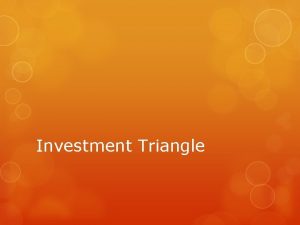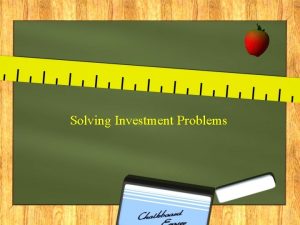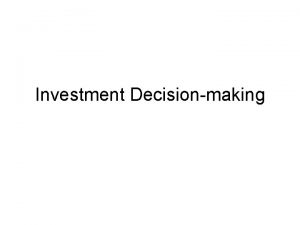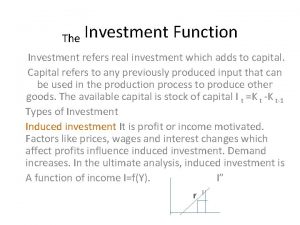INSTRUCTUS MARKETS INTRODUCTION TO CAPITAL MARKETS AND INVESTMENT











































































- Slides: 75

INSTRUCTUS MARKETS INTRODUCTION TO CAPITAL MARKETS AND INVESTMENT BANKING navigating the financial world

GILES JOHNSTON Giles began his career on the Stock Exchange floor at Big Bang in 1986, trading for Nat-West markets. Following this he joined Deutsche Bank and then Citigroup where he was Managing Director responsible for Energy trading. Alongside his main function as a senior equities trader, Giles has also had responsibility managing the relationship between markets and corporates. Giles has been a regular speaker at the Citi Investor Relations University and has delivered many successful corporate pitches.

GRAHAM SMITH Graham began his career as a trader at Smith Barney in 1996 before joining Citigroup as managing director of European Trading and subsequently Unicredit as Global Head of Trading and Sales Trading. Graham was promoted to Managing Director at the age of 30, running a team of 50 and a trading portfolio of $3 bn. As well as delivering Instructus training courses in Capital Markets and Trading, Graham also runs a Pan-European fund for Trafalgar Capital, a global hedge fund.

AGENDA • Terminology • Role and function of capital markets • Introduction to asset classes • Buy side and sell side activities • Investment Bank divisions • Roles within investment bank • Operations • Regulation and compliance

CAPITAL MARKETS

WHAT ARE CAPITAL MARKETS? • Capital markets exist to allow companies to raise money by selling a part of their business to investors (equities) or to borrow money, through issuing debt (bonds) • A market where a government can raise money (capital) to fund their operations. • The initial stage of raising this capital is called the primary market, prior to listing on an exchange • The subsequent trading of these bonds or equities is known as the secondary market • Modern day integrated investment banks are involved in both the primary and secondary markets

THE IMPORTANCE OF CAPITAL MARKETS • Provide an exit strategy for privately owned companies to realise their value • Provide an entry strategy for investors looking to benefit from a company’s growth and distribution of earnings • Pension and investment funds receive an income through dividends, bond yields and capital appreciation, allowing them to pay pension holders

TERMINOLOGY • Basis points: 1% is 100 basis points • OTC: Over the counter: display prices but no firm commitment. Most bond markets • Order driven market: where buyers and sellers display prices at which they would buy and sell assets • Short position: Selling an asset that you don’t already own. • Primary: Capital raising • Secondary: Trading of listed assets • IPO: Initial Public Offering, the listing of securities, selling to institutions and the public • ECM: Equity Capital Markets • DCM: Debt Capital Markets

ORDER DRIVEN MARKET Source Bloomberg

INTRODUCTION TO FINANCIAL MARKETS Recent stock market history: • Traditionally, jobbers and market makers were the point of execution • Clients were obligated to place orders through brokers • Clients were predominantly pension funds, insurance companies and professional institutional investors • “Big Bang” in 1986 gave birth to the modern market: market makers, brokers and merchant banks merged into integrated investment banks

INTRODUCTION TO FINANCIAL MARKETS Recent stock market history: • Significant capital injections catalysed explosive growth in trading volumes • Total levels of market risk rose exponentially • First stage of electronic trading allowed prices to be advertised on screens across banks • Early 1990’s market became order driven (spreads narrowed sharply) • Investment banking margins therefore declined (volumes increased dramatically) • Late 2000’s, direct market access offered to buy side clients

THE OLD STOCK EXCHANGE FLOOR

OVERVIEW OF THE FINANCIAL SERVICES INDUSTRY Key participants of the primary market • Corporations: large and small, listed and unlisted companies • Governments • Asset managers/Private equity • Advisory services of the investment banks

OVERVIEW OF THE FINANCIAL SERVICES INDUSTRY Key participants of the secondary markets Asset managers (buy side) • • Pension funds Insurance firms Hedge funds Retail funds Investment funds Private wealth management Private Equity Firms Advisory and execution services (sell side) • • Investment banks Brokers

ASSET CLASSES

ASSET CLASSES Shares (Equities) • What are they? • Publicly listed companies traded on an exchange • Most listed shares traded via order driven market • Many pay dividends, FTSE 100 yields about 3. 5% • Investment banks subdivide the market by market capitalisation • Specific funds for smaller companies • Companies become public via an IPO (Facebook, Twitter and Royal Mail) • Twitter shares issued at $26, trade at $45 on first day of trading • This year has seen the largest number of IPO’s in the US since 2007 • Free float is the percentage of shares floated at an IPO • Not necessarily listed in home market (Prada and Alibaba) • ADR’s (American Depositary Receipts) • Liquidity

TRADED VOLUME IN A LIQUID STOCK Source Bloomberg

TRADED VOLUME IN AN ILLIQUID STOCK Source Bloomberg

VOLATILITY OF A LIQUID STOCK Source Bloomberg

VOLATILITY OF AN ILLIQUID STOCK Source Bloomberg

INDEX WEIGHTING Primary weightings FTSE= miners, oil and gas, financials DAX= Industrials, consumers, financials S&P= Tech but broad based

ASSET CLASSES Foreign Exchange • Currencies of countries • Traded in pairs, one against another • No income • Multinational companies hedge their currency exposure • Represents prospects of one country’s economy compared with another • Central bank intervention in FX markets (most recently Japan) • Currencies often affect the price of commodities • Each currency has its own risk profile • Highly liquid market, open 24 hrs a day (apart from weekends) • Average daily volume is $5 trillion

GBP/USD Source Bloomberg

ASSET CLASSES Commodities • Either Hard (gold, silver, copper, oil) • Or Soft (tea, coffee, cocoa, sugar) • Prices driven by supply and demand, and speculation • Trade in contracts, usually one month and lot size, e. g. 1 lot =1000 barrels • Gold is seen a hedge against inflation and a safe haven • Iron ore and copper: Industrial metals, affected by global growth • Oil can move on geopolitical factors and economic outlook as well as supply and demand, however US shale gas boom has had a significant impact on volatility • Armajaro, recently sold to Ecom (soft) and Glencore Xstrata are two of the biggest participants.

ASSET CLASSES: GOLD Commodities • Either Hard (gold, silver, copper, oil) • Or Soft (tea, coffee, cocoa, sugar) • Tea prices have fallen 35% this year on bumper crop and Egyptian crisis • Prices driven by supply and demand, speculation and weather • Trade in contracts, usually one month and lot size, e. g. 1 lot =1000 barrels • Gold is seen a hedge against inflation and a safe haven • The cost of producing a troy ounce is $1200 for some miners • Iron ore and copper: Industrial metals, affected by global growth • Oil moves on political tension in Middle East as well as speculation and demand • Along with the major investment banks, Armajaro (soft) and Glencore Xstrata are two of the biggest participants.

BRENT CRUDE OIL 1 YEAR GRAPH Source Bloomberg

ASSET CLASSES Commodities • Physical operators, such as airlines, use commodity derivatives to hedge their exposure • Traditionally these derivatives were sold by investment banks • Post the financial crisis and the capital constraints some banks have pulled away from offering derivative hedges • Oil groups and utility companies have filled the gap. In 2008 oil and utility companies had approximately 5% market share, that has now grown to between 25% and 33%

ASSET CLASSES Bonds (also known as Credit, Debt or Fixed income) • A debt issued with a fixed return (coupon) to the lender • Corporate or Sovereign (50 -50 by value) • Predominantly traded OTC (US accounting for about 50%) • Goldman Sachs developing electronic trading platform • Yield of a bond represents the cost of borrowing (terms 1, 3, 5 and 10 years) • Higher the yield, the more expensive it is to borrow • Yield indicates the risk associated with that bond (higher yield, higher risk) • Yield moves inversely to the price of a bond

ASSET CLASSES Bonds (also known as Credit, Debt or Fixed income) • Inverse relationship between bond valuations and interest rates • Allows corporates and sovereigns to ‘lock in’ interest rates for a defined period • We have seen a rush by US corporations to issue bonds ahead of possible Fed tapering • Verizon raises $50 bn in bond market • Some countries have very high yields (Spain 10 yr was at over 7% now 2. 5%) • Safe haven countries are at record lows (German 10 yr bund 0. 9%) • Pimco and Vanguard are two of the largest investors in bonds • Deutsche Bank is ranked Number 1 in fixed income

SPANISH 10 YR BOND YIELD VS EUROSTOXX 50 Source Bloomberg

ASSET CLASSES Bond ratings Three main companies rate sovereign and corporate bonds: o Moody’s o S&P (Standard and Poor’s) o Fitch • Rated from AAA (highest) to junk status (BBB-) • Each rating helps determine the level of risk associated with a bond • Highly rated bonds (AAA) will have the lowest yield and vice versa • Only four US companies have AAA, Microsoft, J&J, Exxon and ADP • Rating firms can also give an outlook that suggests which way the rating may move: o Positive, stable, negative

ASSET CLASSES ETF’s, CDO’s, and CDS’s • Exchange Traded Funds: A security that tracks an index, a commodity or a basket of assets • Collateralised Debt Obligation: An asset backed security, usually backed by a collection of bonds, loans and other assets. Trades in tranches which will have different risk profiles and have coupons that represent that risk profile. • Credit Default Swaps: Insurance against non-payment on a fixed income product. The buyer of the swap pays to protect against default, the seller of the swap pays out in the event of default

BUY SIDE AND SELL SIDE FUNCTIONS

BUY SIDE & SELL SIDE Buy Side • • • Investment Funds (focused on specific regions, sectors, designated risk profile: Fidelity) Pension Funds (long term, low risk, income generating: British Airways Pension Fund) Quantitative funds: investment decision based on computer modeling Hedge Funds (shorter term, higher risk, highly leveraged portfolio trading: Moore Capital) Private wealth management (broad based investment of private clients money) Most of the above have their own dealers Historically longer term and long only investors Receive fees according to AUM (1 -2% management fee) Clients have a mandate (suggests risk profile of the client’s investments) Buy side pays for services of the sell side, on an unbundled basis

BUY SIDE & SELL SIDE Sell Side • Investment Banks and brokers (Goldman, JP Morgan, Numis) • Gateways to the market (execute orders on behalf of the buy side) • Commissions paid for research advice, distribution and execution services • Traders execute orders from buy side institutions (agency or risk) • Capital Markets (IPO’s, Rights Issues, Placings) • Trading/research/sales (in bonds, equities, commodities or FX) • Deal with institutional clients (Fidelity, Legal & General, Moore Capital)

TECHNOLOGY AND INVESTING

ASSET CLASSES High Frequency Trading • Sophisticated computer technology using algorithms to trade securities at very high speed and volume • Proprietary trading strategies • US is the biggest market for HFT with Asian markets the smallest. • Very rapid turnover with positions often held for seconds • Highly active at times of rebalancing • No open positions at the end of the trading session • Arms race for fastest and closest computer (to exchange) • Debate as to the merits of HFT, distortion of volume or improved liquidity • France is moving to ban HFT post ‘flash crash’ in the US • Italy introduces tax on HFT (2 nd September) • Talk of ‘speed limits’ to make a more level playing field

TECHNOLOGY Algorithmic Trading • Advanced computer programs that execute orders automatically, following predetermined instructions • • • Over 90% of all trading is transacted through a computer algorithm • Constantly updating and improving to try and prevent ‘gaming’ Smart order routers designed to have market beating performance Still requires human input and monitoring Program trading makes up about 30% of the NYSE daily volume Many strategies including Volume Weighted Average Price (VWAP), Time Weighted Average Price (TWAP) and percentage of volume (POV)

TECHNOLOGY Dark Pools • Dark pools: Hidden liquidity usually traded off exchange through crossing networks • Originally designed for the anonymous trading of large blocks of stock between institutions • Dark liquidity now makes up approximately 7% of total volume • Average trade size now only 200 shares • Several exchanges are trying to limit the amount of business transacted in dark pools • Hidden liquidity on exchange: Iceberg orders that show only a small percentage of the total order and hidden orders

BUY SIDE TECHNOLOGY Direct Market Access: DMA • The ability of buy side dealers to access the market through a sell side firm’s trading platform without any direct contact, eg. Blackrock using Citi’s systems. • Nomura bought Instinet in 2006 opening the way for buy side firms to be able to work their own orders rather than relying on the investment banks to trade for them • The client still pays the sell side a commission for using their technology, but at a vastly reduced rate There are numerous advantages for the buy side institutions: • Cost of execution • Speed of execution • Anonymity

INVESTMENT BANK DIVISIONS

INVESTMENT BANK DIVISIONS Two Principal Activities: Primary and Secondary • Capital markets, corporate advisory and mergers and acquisitions o Fees are usually paid on a deal basis as a percentage of value (some clients pay a retainer) • Markets division, research, sales and trading o Revenue generated through commission and trading (some clients will pay for research by cheque)

INVESTMENT BANK DIVISIONS Capital Markets: Primary • Capital markets split into both equity and debt (ECM & DCM) • Provide advice and product solutions for equity and debt capital raising; o IPO’s o Bond issues o Capital Increases (Rights issues) o Convertible bonds o Private placements (Barclays)

INVESTMENT BANK DIVISIONS Capital Markets: Primary • Initial Public Offering (IPO) o Senior management of the corporate (for example Moncler and their private equity partners) meet with Capital Markets teams o Ensure underwriting firms are in place (syndicate of banks) o Liaise with bank’s sales team and buy side community to determine demand (roadshows) o Allocate those shares to clients at the issue price o Speak with traders responsible for the Green Shoe

INVESTMENT BANK DIVISIONS

INVESTMENT BANK DIVISIONS Capital Markets: Primary • • Secondary listings (Rights Issues) o Issuance of new shares to existing shareholders o Shareholders have the right but not the obligation to take up the rights o Rights are offered to existing shareholders on a pro rata basis (i. e. 2: 1) o Underwriters in place Convertible Bonds o Issuing debt in the form of a bond (raise capital) o Bonds are convertible to stock (equity) at a predetermined price o Offers a coupon of lower yield as risk is lessened by its convertible nature o Cheap way of raising finance for the issuer

INVESTMENT BANK DIVISIONS Capital raising by Barclays • £ 5. 8 billion rights issue • £ 2 billion convertible bond • Fourth largest rights issue by a UK bank • Terms of issue: 1 for 4 at £ 1. 85 (40% discount to closing price) • To strengthen their balance sheet in line with Prudential Regulation Authority stipulations • £ 12. 8 billion shortfall • Cutting assets by £ 60 -80 billion • Four investment banks handling the issue: Citi, Deutsche Bank, Credit Suisse and Bank of America Merrill Lynch

INVESTMENT BANK DIVISIONS Advisory Departments: Corporate finance: o Raising and managing financing for bank’s corporate clients o Budgeting and financing new projects and developments (large capital intensive projects) o Funded either through debt or equity (ECM or DCM involved) o Both long and short term focused (cash, projects, dividends, debt refinancing etc) o Helps maintain a relationship between the bank and its corporate clients

INVESTMENT BANK DIVISIONS Advisory Departments: M&A: o Responsible for the merger or takeover process between two corporate parties: for example Pfizer’s approach to Astra. Zeneca (tax inversion deal) o Most recent UK approach is Microchip (US) for CSR (UK) o Work with corporate finance to manage the funding of this process o Funding either through cash, equity or debt o Undertake high level of due diligence (nb: Autonomy and Hewlett Packard) o Last week $100 bn of deals fell through (huge loss of fees) o Work behind Chinese Wall from other departments o Party to price sensitive information

CHINESE WALLS

IMPORTANCE OF CHINESE WALLS • A virtual and sometimes physical barrier between departments • Used to prevent the dissemination of price sensitive information within a firm • Is a criminal act to pass on or knowingly act on price sensitive information • How do you determine what is and isn’t price sensitive information? • To which departments is this most relevant? Steve Cohen of SAC partners fined $1. 8 bn and banned from managing external investments after pleading guilty to insider trading, possible criminal case to follow.

INVESTMENT BANK DIVISIONS Advisory Departments: Corporate finance: o Vodafone to sell it’s Verizon stake for $130 bn o The transaction will be the 3 rd largest M&A deal ever o Most of the proceeds to be returned to shareholders o Verizon’s bankers, including JP Morgan, Morgan Stanley and Bo. A Merrill Lynch are set to underwrite over $60 bn in debt to finance the deal o The disposal will be largely tax free as it involves selling a stake in a US domestic to a domestic buyer

PRIME BROKERAGE Investment bank (sell side) service to Hedge Funds (buy side) • Prime Broker holds positions (shares) on behalf of the client • Usually trades via CFD (Contract for Difference) • Tax efficient means of operating • Provide centralised clearing facility • Provide the opportunity to borrow stock (to fulfill obligations on short positions) • Offer access to leverage • Can offer a sales trading service to their clients (market advice and insight)

ROLES WITHIN CAPITAL MARKETS Research • Analysing companies within sectors and regions • Large reliance on models within research coverage • Provide a recommendation on assets covered (buy, hold, sell) • All published material is vetted by compliance • Research analysts ranked by external surveys of clients (Extel) • CFA exam a likely requisite for an analyst role Sales & Specialist Research Sales • Generalist sales people will market all ideas to clients • Specialist sales promote specific sectors • All sales executives tailor research advice to meet client needs

RIO ANALYST RECOMMENDATIONS Source Bloomberg

ROLES WITHIN CAPITAL MARKETS Sales Trading • Provide timely and pertinent information, ideas, advice and support to clients • Speak to the dealing desk of the client • Backing of the banks capital base • Close working relationship with sales and trading • Source liquidity Trading • Agency and Market Making • Proprietary and Special Situation Trading • AE, Algorithm, Program Trading • Liquidity, risk management and commission retention

ROLES WITHIN CAPITAL MARKETS Delta 1 • Delta 1 products are a type of derivative • These products move in a very similar way to the underlying asset (almost exactly) • The SPDR (know as spider) is an EFT of the S&P index • Structured products that can be customised to suit client needs • Use fairly large amounts of capital but generally profitable • HFT active in this area • Enable banks to take risk (not bound by the same regulation as the rest of trading) • High prolife losses such as at UBS and Soc Gen

PRIVATE EQUITY & VENTURE CAPITAL

ROLES WITHIN FINANCE: PRIVATE EQUITY Private equity firms raise funds to acquire a controlling or substantial stake in a company, then look to maximize the value of that investment. • • Will usually have a spread of investments to mitigate risk. They will receive a management fee and also a percentage of any profits Value can be created in various ways; o Change the strategy: strengthen the management team o Capital expenditure/investment o Lowering the cost of capital o Growth through mergers and acquisitions

ROLES WITHIN FINANCE: PRIVATE EQUITY Private equity investments are long term (usually at least 5 years) Exit strategies • • • Initial Public Offering (Eurozeo sells half its stake in Moncler at float) Trade sale (M&A) either for cash or equity in acquirer ( 65% of deals in 2012) Recapitalisation: Pay cash distribution from cash flow or raise debt to finance distribution The largest private equity firms include: TPG The Carlyle Group Blackstone Silver Lake (recently part of the Dell deal) KKR Terra Firma (European)

ROLES WITHIN FINANCE: VENTURE CAPITAL Venture capital firms are similar to private equity but usually invest at an earlier stage of a company’s development and don’t necessarily have a controlling stake or board representation. • A broad spread of investments as early stage investment does have a high failure rate. • VC’s are frequently providers of seed funding to early-stage firms (which might struggle to raise capital elsewhere) • Invest cash in exchange for an equity stake • Exit strategy is usually through trade sale or IPO • Summly bought by Yahoo for $30 mn

OPERATIONS

ROLES WITHIN OPERATIONS Operations: middle office (usually based on the trading floor) • Confirmation of order execution • Allocation of assets to client funds • Price and quantity reconciliation • Confirmation with client T+1 (1 day) • Maintaining detailed records of transactions • Corporate action: dividends, rights issues, share consolidation, buy-ins • Relationship management with trading counterparts • Ensuring the integrity of the bank’s trading positions and P&L

ROLES WITHIN OPERATIONS Operations: middle office • Liaise with the banks treasury department to ensure sufficient funding is available for warehoused positions and trading inventory • In an era of contraction of commission revenue it is vital that middle office operations are as efficient as possible • Recently we have seen many buy side institutions merge their fixed income and equities middle office operations

LIFE CYCLE OF A TRADE

ROLES WITHIN OPERATIONS Compliance The role of the compliance department is protect the firm and employees against breaches of codes and ethics, covering topics such as: • KYC: ‘Know Your Customer’ • Bribery Act • Anti-money laundering legislation • Market abuse • Conflict of interest • Insider trading With increased levels of regulation compliance is one of the fastest growing divisions within the financial services sector.

THINK SMART : OUTSIDE THE BOX Consider smaller investment banks and brokers • Macquarie: Provides advice, capital raising, fund management, research, sales and trading (Australian) • Mirabaud: Similar services to the above. Based in London, with Swiss parent. • Brewin Dolphin: One of the UK’s largest independent private client stockbrokers with £ 26 bn under management and 40 UK offices. • Numis: A leading small and mid cap institutional stockbroker based in London and New York. • Redburn: Europe’s largest independent equities broker, producing conflict-free institutional research.

THINK SMART : OUTSIDE THE BOX Global Transaction Services (within investment banks) • Strategic advice on custody, settlement, securities infrastructure and emerging markets • White label products used by other financial institutions • Fast growing business (Citi has 22, 000 employees in 100 countries) • Very profitable • Can be used as stepping stone (Tom)

REGULATION Highly regulated environment • Basel III (capital requirements) • Dodd Frank • Volcker Rule (Proprietary trading) • Financial Transaction Tax (since its introduction in March Italy has seen a significant reduction in trading volume on its exchange) Increasing political and regulatory intervention within the industry to mitigate risk of bank failure

THINK SMART : OUTSIDE THE BOX Technology • Technology plays such a vital role with financial services • Constantly evolving and improving • Part of the front office infrastructure • Many senior executives have progressed from IT roles

THINK SMART : OUTSIDE THE BOX Maximise your chances by considering large companies outside finance • Big corporations with foreign exchange flows and borrowing requirements • Big enough to have a treasury department. This department will be responsible for lines of credit, bond issuance and foreign exchange trading • For example truly international companies: BP, Royal Dutch Shell, Inditex, Vodafone, BASF, BMW • Most large European listed companies.

THINK SMART : OUTSIDE THE BOX European Merger and Acquisitions • US Investment banks dominate the largest transactions, leading firms include JP Morgan, Morgan Stanley and Goldman Sachs • Smaller deals of $500 m and under are less dominated by the investment banks. Consultants firms Pw. C and KPMG and merchant banks such as Rothschild are very active in this area

THE FUTURE OF THE INDUSTRY

THE FUTURE With new technology and the failures of risk management being the biggest themes of the past decade, what will be the next chapter in the permanent revolution? • Corporate activity and M&A • IPO market • Return of leveraged buyouts and private equity deals • Asset managers fees • Banks risk profile/liquidity • Bond markets becoming order driven • Regulation • Expansion of graduate programs back to pre crisis levels

DISCLAIMER All information contained on this website (and in any forums, blogs, round-ups and news updates provided through this website) is given without any warranty, promise or representation of any kind whatsover. Whilst we provide our courses and all our other services with reasonable care and skill (and in booking any course you agree to accept our terms and conditions (www. instructustrading. com/legal), we do not promise, warrant, guarantee any particular results from your trading. In booking or attending any Course you accept and acknowledge that: • (i) we will not advise you what or when to buy, sell, invest or otherwise deal; • (ii) the advice we will give you is only aimed at encouraging a good understanding of the practicalities of how to trade; • (iii) by its nature, trading is very risky, requiring sophisticated levels of understanding, knowledge, information and a variety of strategies for it to be profitable; and • (iv) you may lose all monies you place at risk and, in relation to spread-betting and other forms of trading or gambling, you may incur liabilities to pay further monies or provide capital in addition to losing such monies. We are not regulated by or registered with the Financial Services Authority or authorised or otherwise permitted to carry out any investment business or other regulated activity.
 Investment banking products
Investment banking products Fixed investment and inventory investment
Fixed investment and inventory investment Efficient capital markets and behavioral challenges
Efficient capital markets and behavioral challenges Capital markets and financial intermediation
Capital markets and financial intermediation Efficient capital allocation
Efficient capital allocation Structure of indian capital market
Structure of indian capital market Metsä board osinko
Metsä board osinko Features of capital market
Features of capital market Pricing of securities in stock exchange
Pricing of securities in stock exchange Investment and securities tribunal
Investment and securities tribunal Efficient capital markets ii
Efficient capital markets ii Equivalent annual cost method
Equivalent annual cost method Factors that complicate capital investment analysis
Factors that complicate capital investment analysis How to calculate incremental cash flows
How to calculate incremental cash flows Factors that complicate capital investment analysis
Factors that complicate capital investment analysis Scottish capital investment manual
Scottish capital investment manual When evaluating cost-cutting proposals
When evaluating cost-cutting proposals Making capital investment decisions
Making capital investment decisions Capital investment analysis is the process
Capital investment analysis is the process Factors that complicate capital investment analysis
Factors that complicate capital investment analysis Making capital investment decisions
Making capital investment decisions Tax shield formula
Tax shield formula Making capital investment decisions
Making capital investment decisions Nwc change
Nwc change Fixed capital and working capital
Fixed capital and working capital Difference between capital reserve and reserve capital
Difference between capital reserve and reserve capital Multinational cost of capital and capital structure
Multinational cost of capital and capital structure Difference between capital reserve and reserve capital
Difference between capital reserve and reserve capital Constant capital and variable capital
Constant capital and variable capital Multinational cost of capital and capital structure
Multinational cost of capital and capital structure Cisi introduction to securities and investment
Cisi introduction to securities and investment Basle ii
Basle ii Regulatory capital vs economic capital
Regulatory capital vs economic capital Capital allocation line vs capital market line
Capital allocation line vs capital market line Introduction to strategic hospitality technology investment
Introduction to strategic hospitality technology investment Agency cost
Agency cost Interlanguage and social identity and investment
Interlanguage and social identity and investment Stylistic continuum
Stylistic continuum Why study financial market
Why study financial market Financial markets and institutions jeff madura ppt
Financial markets and institutions jeff madura ppt Consumers producers and the efficiency of markets
Consumers producers and the efficiency of markets Historic tax credit structure diagram
Historic tax credit structure diagram Black box model consumer behaviour
Black box model consumer behaviour Chapter 9 expanding markets and moving west
Chapter 9 expanding markets and moving west Business markets and business buyer behavior
Business markets and business buyer behavior Analyzing consumer and business markets
Analyzing consumer and business markets Product-market boundaries and structure
Product-market boundaries and structure Business markets and buying behaviour
Business markets and buying behaviour Financial markets and institutions - ppt
Financial markets and institutions - ppt Urban economics and real estate markets
Urban economics and real estate markets Dartmouth sociology major
Dartmouth sociology major Mutual fund flows and performance in rational markets
Mutual fund flows and performance in rational markets Financial intermediary
Financial intermediary Chapter 5 consumer markets and buyer behavior
Chapter 5 consumer markets and buyer behavior Similarities between consumers and organizational markets
Similarities between consumers and organizational markets Target market and channel design strategy
Target market and channel design strategy Chapter 5 consumer markets and buyer behavior
Chapter 5 consumer markets and buyer behavior International financial markets and instruments
International financial markets and instruments Consumers producers and the efficiency of markets
Consumers producers and the efficiency of markets Vertical and horizontal markets
Vertical and horizontal markets Introduction to futures and options
Introduction to futures and options Primary vs secondary financial markets
Primary vs secondary financial markets Digital markets and digital goods
Digital markets and digital goods Input and output market
Input and output market Types of exchange rate
Types of exchange rate Equity markets and stock valuation
Equity markets and stock valuation Analyzing consumer markets ppt
Analyzing consumer markets ppt Financial markets instruments and institutions
Financial markets instruments and institutions Madura j. financial markets and institutions
Madura j. financial markets and institutions Strategies for mature and declining markets
Strategies for mature and declining markets Pilbeam k. finance and financial markets
Pilbeam k. finance and financial markets Finance and financial markets keith pilbeam
Finance and financial markets keith pilbeam Equity securities
Equity securities Expanding markets and moving west
Expanding markets and moving west Madura j. financial markets and institutions
Madura j. financial markets and institutions Article 20-c food processing license
Article 20-c food processing license
